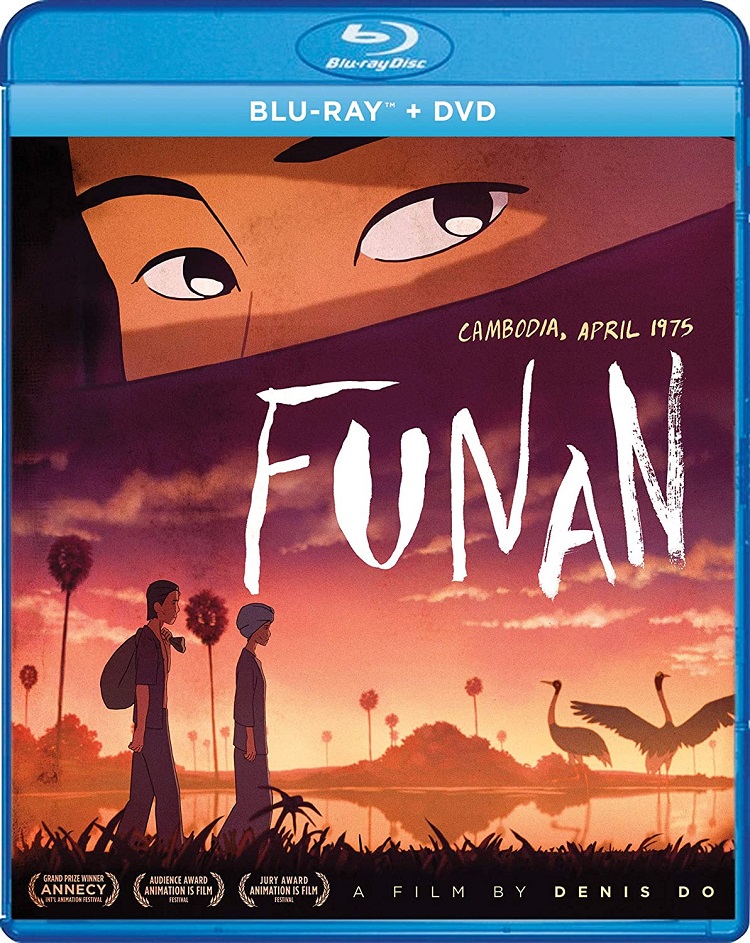
In the mid to late 1970s, the Khmer Rouge ruled Cambodia as one of the most brutal regimes in modern history. Led by Marxist leader Pol Pot, the Khmer Rouge wanted to take Cambodia back to what they called “Year Zero” or an egalitarian, agrarian society cleaned from what they thought to be the terrible influences of capitalism. On a practical level, this meant emptying the cities and marching everyone into rural collectives where they would be forced into slave labor. Anybody thought to be an intellectual (including those who wore glasses or spoke a second language) were summarily executed. Children were separated from their parents. People died by the hundreds of thousands due to disease, starvation, and exhaustion.
Dennis Do’s beautiful animated film Funan tells this terrible story. He based it on both historical facts and the stories of his mother who survived the Khmer Rouge, escaping to Thailand in 1979. It begins with the fall of Phnom Penh, Cambodia’s capital city where thousands of people were forced to evacuate by Khmer Rouge soldiers, many of whom were but teenagers themselves, into labor camps.
It follows one family – Chou (Bérénice Bejo), her husband Khuon (Louis Garrel), their young son, and his grandmother – on that long journey. When the boy falls behind, grandmother chases after him but Chou and Khoun are forced to march on. A soldier tells them the boy will be relocated to another camp but is safe. Clearly this is a lie, and most of the film focuses on his parents’ fear over what happened to him and their despair at not being able to help.
They are led to an encampment where they are forced to work day and night planting crops. The Khmer Rouge took its purpose from small villages around Cambodia who lived simple lives of farming without private property and an abundance of wealth and tries to create this on a large scale. An interesting idea but one doomed to failure as how to make this work seems to have consisted of threatening people who had no idea how farms worked with their lives unless they could grow an abundance of crops. Chou and Khuon work, and work, are fed small handfuls of rice each day, and are constantly threatened. It is a living hell with no end in sight.
The animation is quite beautiful. The film often pulls back to show off the Cambodian landscape full of mountains, trees, and rice fields. The juxtaposition between the extreme violence taking place there and the pure serenity of the land is stunning. Do often allows the violence to take place off screen. He’ll pull away just before someone is shot or beaten, giving us reaction shots of the poor people standing nearby. The film is saturated in the horror we know is taking place all around, but it doesn’t glorify it. It never zooms in on the gore, never cheapens it.
It is light on politics. We are periodically given dates flashed across the screen, but there isn’t much exposition. There aren’t cutaways to the leaders discussing what the purpose of all this is. I’ve traveled to Cambodia; I’ve walked the Killing Fields. I’ve read some of the histories so I was able to fill in the details, but I wonder what someone who knows nothing of this time and place would understand. Surely, they would get that something terrible is happening. That thousands of people have been taken from their homes and forced into labor camps. By focusing on this one family, the film allows us to understand the intensity of their struggle without getting lost in the larger picture.
That idea to focus on a singular story without giving details to a larger political perspective is an interesting one. It doesn’t always work, especially as it often jumps forward in time, preferring to tell its story in small vignettes rather than a cohesive whole. But the weight of what is happening can be truly seen in these characters.
Chou is often seen laying in bed after a long day’s work. She is exhausted and malnourished, worn to the bone. You can see her letting herself fade away into nothingness except for the thought of her son. She can ensure anything if she can see her son again. That thought, that hope, keeps her alive.
When they are first forced to march out of the city, they realize they are heading towards a village where their cousin Sok (Thierry Jahn) lives. Their hopes of receiving help from him are quickly dashed when they see he is wearing the colors of the Khmer Rouge. The message of the Khmer Rouge grew from the villages to people living in poverty. It preached a message of equality where the rich would share and life would be wonderful. It grabbed a hold of the people and led them to commit grave atrocities.
But all is not lost. In real life, the Khmer Rouge fell after only a few years in power. By 1979, the Vietnamese invaded, removing them from power. The film too finds hope with an escape into Thailand.
GKIDS has steadily been releasing some of the best-animated films being made all over the world. The name always feels a bit like a misnomer because films like Funan and many others are in no way appropriate for children, but they are wonderful works of art.
Funan is presented with a 1080p transfer in an aspect ratio of 2.39:1 with its original French audio and English subtitles. Extras include interviews with the director, an art gallery, storyboards, and trailers.